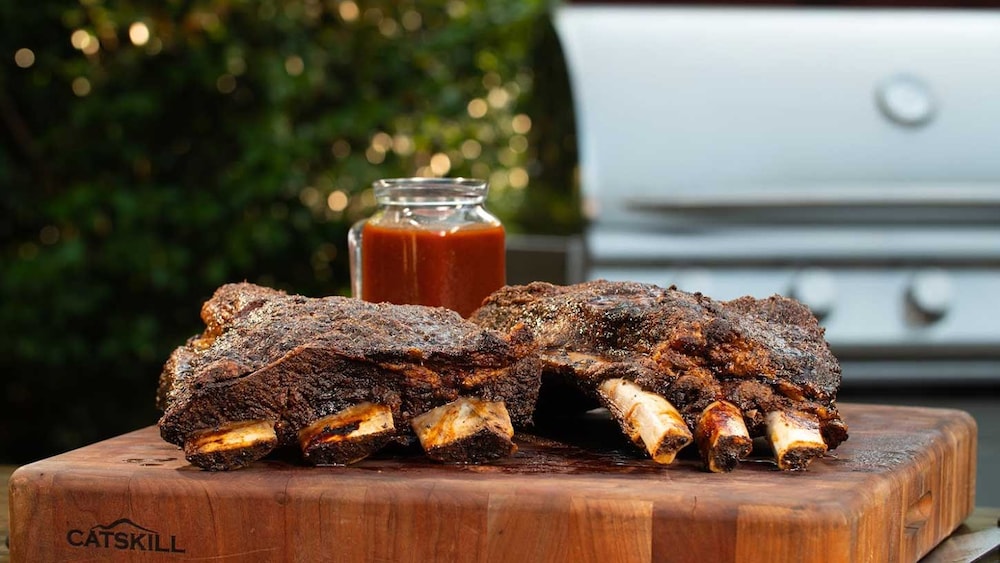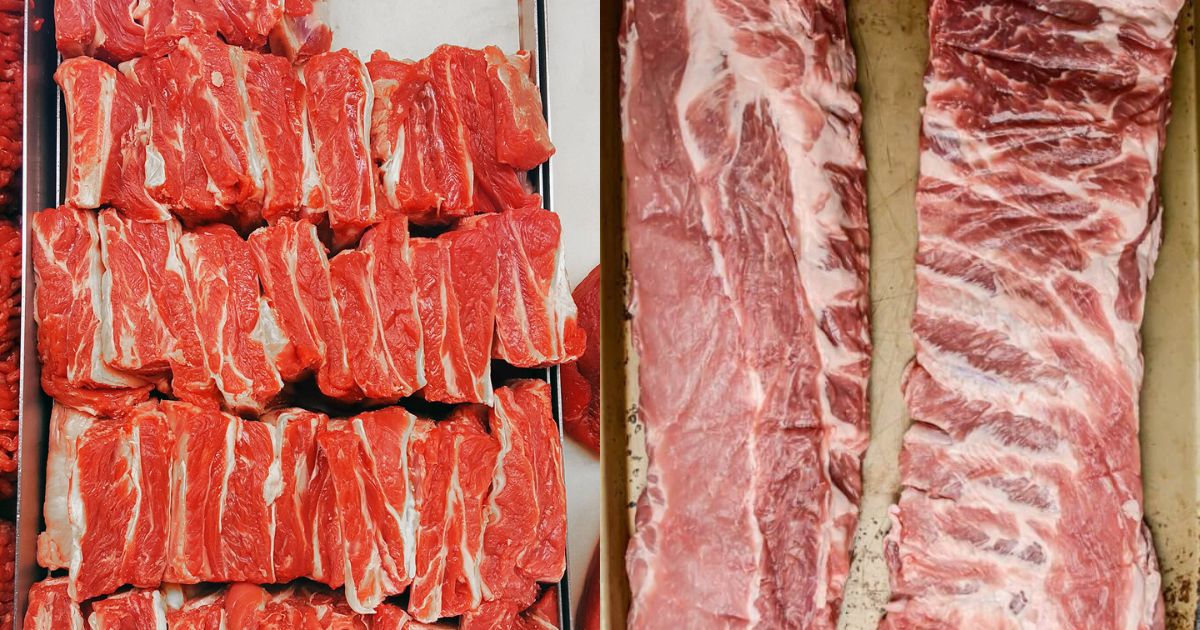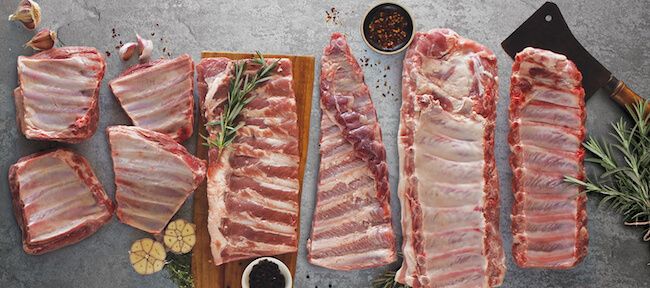
Introduction
When it comes to barbeque, few things are more delicious than a plate of succulent ribs. Two types of meat that are often the stars of BBQ menus are beef and pork ribs. These meats have their own distinct flavors and textures, creating a BBQ showdown that has sparked many debates among meat enthusiasts. In this blog post, we will explore the popularity of beef and pork ribs in BBQ culture, as well as the different cuts of each.
The Popularity Of Beef And Pork Ribs In BBQ Culture
Both beef and pork ribs have loyal fan bases that can argue for hours about whether beef or pork ribs reign supreme. Each type offers a unique taste and experience when grilled correctly. Beef ribs are known for their thickness and meatiness, offering a rich and flavorful bite. On the other hand, pork ribs are celebrated for their tenderness and juiciness, with the meat falling off the bone. Both types of ribs are beloved by BBQ enthusiasts and are often the star of backyard cookouts and professional BBQ competitions.
Different Cuts Of Beef And Pork Ribs
Beef and pork ribs come from different parts of the animal, resulting in variations in taste and texture. Here is a comparison of the cuts of each:
| Beef Ribs | Pork Ribs |
|---|---|
| Thick and meaty | Tender and juicy |
| Fattier and more flavorful | Fattier and pretty darn tasty |
| Require longer cooking time | Cook faster |
In conclusion, both beef and pork ribs have their own unique qualities that make them popular in BBQ culture. The choice between the two ultimately comes down to personal preference. Beef ribs offer a fattier and more flavorful experience, while pork ribs are known for their tenderness and juicy meat. Whichever type you choose, one thing is for sure – a plate of perfectly grilled ribs is a BBQ delight that will satisfy any meat lover.
Beef Ribs
When it comes to barbeque, few things are more delicious than a plate of succulent ribs. Two types of meat that are often the stars of BBQ menus are beef and pork ribs. These meats have their own distinct flavors and textures, creating a BBQ showdown that has sparked many debates among meat enthusiasts. In this blog post, we will explore the popularity of beef and pork ribs in BBQ culture, as well as the different cuts of each.
The Popularity Of Beef And Pork Ribs In BBQ Culture
Both beef and pork ribs have loyal fan bases that can argue for hours about whether beef or pork ribs reign supreme. Each type offers a unique taste and experience when grilled correctly. Beef ribs are known for their thickness and meatiness, offering a rich and flavorful bite. On the other hand, pork ribs are celebrated for their tenderness and juiciness, with the meat falling off the bone. Both types of ribs are beloved by BBQ enthusiasts and are often the star of backyard cookouts and professional BBQ competitions.
Different Cuts Of Beef And Pork Ribs
Beef and pork ribs come from different parts of the animal, resulting in variations in taste and texture. Here is a comparison of the cuts of each:
| Beef Ribs | Pork Ribs |
|---|---|
| Thick and meaty | Tender and juicy |
| Fattier and more flavorful | Fattier and pretty darn tasty |
| Require longer cooking time | Cook faster |
Both beef and pork ribs have their own unique qualities that make them popular in BBQ culture. The choice between the two ultimately comes down to personal preference. Beef ribs offer a fattier and more flavorful experience, while pork ribs are known for their tenderness and juicy meat. Whichever type you choose, one thing is for sure – a plate of perfectly grilled ribs is a BBQ delight that will satisfy any meat lover.
Pork Ribs
Fat-to-meat Ratio In Pork Ribs
Pork ribs, especially the spareribs cut from the sternum, are known for their higher fat content compared to beef ribs. The fat-to-meat ratio in pork ribs provides them with ample juiciness and flavor. The marbled fat in pork ribs melts during the cooking process, creating a moist and succulent eating experience.
Taste And Texture Of Pork Ribs
Pork ribs have a tender and juicy texture that is popular among BBQ enthusiasts. The meat on pork ribs is more delicate and falls off the bone easily when cooked correctly. The combination of the moist meat and the caramelized BBQ sauce creates a mouthwatering bite that is hard to resist.
The taste of pork ribs is slightly milder compared to beef ribs, allowing the flavors of the rubs and sauces used during cooking to shine through. The natural sweetness of pork complements various flavors, making it a versatile choice for different types of BBQ sauces and seasonings.
Overall, pork ribs offer a lighter and more tender eating experience. They are often preferred by individuals who enjoy a delicate balance of flavors and a melt-in-your-mouth texture. Whether you choose beef or pork ribs, both offer a delicious and satisfying BBQ experience that can take any backyard cookout or professional BBQ competition to the next level.

Comparison Of Fat-to-meat Ratio
Even Distribution Of Fat And Meat In Beef Ribs
In beef ribs, the fat-to-meat ratio is fairly even, resulting in a well-marbled cut of meat. The generous amount of meat in beef ribs is accompanied by a significant amount of fat. This fat adds flavor and moisture to the ribs, creating a delicious and juicy bite.
Meatier But Less Fatty Pork Ribs
In contrast, pork ribs have a higher proportion of meat compared to fat. Although pork ribs contain some fat, it is not as abundant as in beef ribs. The ratio of meat to fat in pork ribs makes them meatier and less fatty overall. However, the smaller size of pork rib bones means there is less meat available compared to beef ribs.
Both beef and pork ribs have their own unique characteristics when it comes to fat-to-meat ratio. Beef ribs offer a well-balanced distribution of fat and meat, while pork ribs are meatier with less fat. The choice between the two ultimately depends on personal preference and desired eating experience.
Comparison Of Fat-to-meat Ratio
Even Distribution Of Fat And Meat In Beef Ribs
Beef ribs are known for their well-marbled cut of meat, with a fairly even distribution of fat and meat. This generous amount of fat adds flavor and moisture to the ribs, resulting in a delicious and juicy bite. The fat-to-meat ratio in beef ribs creates a balance between the two, enhancing the overall taste of the meat.
Meatier But Less Fatty Pork Ribs
Pork ribs, on the other hand, have a higher proportion of meat compared to fat. Although there is some fat present in pork ribs, it is not as abundant as in beef ribs. This makes pork ribs meatier and less fatty overall. However, due to the smaller size of pork rib bones, there is less meat available compared to beef ribs.
Both beef and pork ribs possess their own unique characteristics when it comes to fat-to-meat ratio. Beef ribs offer an even distribution of fat and meat, resulting in a well-marbled and flavorful bite. On the other hand, pork ribs are meatier with less fat, allowing the natural flavors of the meat to shine through. The choice between the two ultimately depends on personal preference and desired eating experience.
Flavor Profile
Intense And Rich Flavor Of Beef Ribs
Beef ribs have a distinctive flavor profile that is often described as intense and meaty. The richness of the flavor is due to the strong beefy taste that comes from the specific cut and marbling of the meat. Beef ribs provide a bold, robust, and satisfying flavor that meat lovers enjoy.
Tasty And Succulent Characteristics Of Pork Ribs
Pork ribs, on the other hand, bring a slightly sweeter and milder flavor compared to beef ribs. The flavor of pork ribs is often described as tasty and succulent. The meat of pork ribs is more delicate, offering a different taste experience compared to beef ribs.
When it comes to flavor, beef ribs have a bold and intense taste, while pork ribs provide a slightly sweeter and milder option. Whether you prefer the robustness of beef ribs or the tastiness of pork ribs, both options offer delicious and satisfying flavors that are sure to please the palate.
Comparison Of Fat-to-meat Ratio
Even Distribution Of Fat And Meat In Beef Ribs
Beef ribs are known for their well-marbled cut of meat, with a fairly even distribution of fat and meat. This generous amount of fat adds flavor and moisture to the ribs, resulting in a delicious and juicy bite. The fat-to-meat ratio in beef ribs creates a balance between the two, enhancing the overall taste of the meat.
Meatier But Less Fatty Pork Ribs
Pork ribs, on the other hand, have a higher proportion of meat compared to fat. Although there is some fat present in pork ribs, it is not as abundant as in beef ribs. This makes pork ribs meatier and less fatty overall. However, due to the smaller size of pork rib bones, there is less meat available compared to beef ribs.
Both beef and pork ribs possess their own unique characteristics when it comes to fat-to-meat ratio. Beef ribs offer an even distribution of fat and meat, resulting in a well-marbled and flavorful bite. On the other hand, pork ribs are meatier with less fat, allowing the natural flavors of the meat to shine through. The choice between the two ultimately depends on personal preference and desired eating experience.
Flavor Profile
Intense And Rich Flavor Of Beef Ribs
Beef ribs have a distinctive flavor profile that is often described as intense and meaty. The richness of the flavor is due to the strong beefy taste that comes from the specific cut and marbling of the meat. Beef ribs provide a bold, robust, and satisfying flavor that meat lovers enjoy.
Tasty And Succulent Characteristics Of Pork Ribs
Pork ribs, on the other hand, bring a slightly sweeter and milder flavor compared to beef ribs. The flavor of pork ribs is often described as tasty and succulent. The meat of pork ribs is more delicate, offering a different taste experience compared to beef ribs.
When it comes to flavor, beef ribs have a bold and intense taste, while pork ribs provide a slightly sweeter and milder option. Whether you prefer the robustness of beef ribs or the tastiness of pork ribs, both options offer delicious and satisfying flavors that are sure to please the palate.
Cooking And Grilling Tips
Techniques For Cooking Beef Ribs
- Slow cooking or braising beef ribs can help tenderize the meat and bring out its natural flavors.- Rubbing a dry spice rub onto the ribs before cooking can enhance the taste and create a flavorful crust.- Using a marinade or basting sauce can add additional flavors to the beef ribs during the cooking process.- Cooking beef ribs low and slow over indirect heat can result in a tender and juicy end result.
Best Practices For Grilling Pork Ribs
- Preparing a sweet and tangy barbecue sauce to baste the pork ribs while grilling can add a caramelized and flavorful glaze.- Applying a dry rub or wet marinade to the pork ribs before grilling can help enhance the taste and create a delicious crust.- Using indirect heat on the grill and periodically turning the ribs can help ensure even cooking and prevent flare-ups.- Grilling pork ribs over medium heat for a shorter duration can help retain the moisture and tenderness of the meat.
By following these cooking and grilling tips, you can ensure that your beef and pork ribs turn out tender, flavorful, and absolutely delicious. Whether you prefer slow-cooked and well-marbled beef ribs or grilled and succulent pork ribs, both options provide an enticing meal that will satisfy any barbecue enthusiast.

Health Considerations
Nutritional Differences Between Beef And Pork Ribs
Beef and pork ribs offer slightly different nutritional benefits due to their varying fat content and vitamin and mineral profiles. Here’s a comparison of the nutritional differences between the two:
| Nutrients | Beef Ribs (3 oz) | Pork Ribs (3 oz) |
|---|---|---|
| Calories | 340 | 280 |
| Protein | 23g | 22g |
| Fat | 26g | 19g |
| Saturated Fat | 11g | 7g |
| Iron | 2.4mg | 1.5mg |
| Vitamin B12 | 1.8mcg | 0.9mcg |
As shown in the table above, beef ribs tend to have slightly higher calorie, fat, and saturated fat content compared to pork ribs. On the other hand, pork ribs are slightly lower in calories and fat. Both types of ribs are good sources of protein, iron, and vitamin B12.
Health-conscious Choices For Rib Lovers
While ribs are delicious, they are also considered indulgent and may not be suitable for everyone’s dietary preferences or health goals. Here are some tips for making health-conscious choices when enjoying ribs:
- Trim excess fat: If you’re concerned about the fat content, consider trimming excess fat from the ribs before cooking or opting for leaner cuts of meat.
- Portion control: Moderation is key. Instead of consuming a large portion of ribs, try to enjoy them as part of a balanced meal alongside vegetables and whole grains.
- Grilling options: Consider grilling or baking ribs instead of frying or deep-frying to reduce the overall fat intake.
- Spice it up: Enhance the flavor of ribs with herbs, spices, and marinades instead of relying solely on fatty sauces or sugary glazes.
Remember, balance is crucial when it comes to enjoying ribs and maintaining a healthy lifestyle. By making smart choices and incorporating ribs into a well-rounded diet, you can still savor the deliciousness without compromising on your health goals.
The Great Beef Ribs Vs. Pork Ribs BBQ Debate
Different Opinions Among BBQ Enthusiasts
When it comes to BBQ, one of the biggest debates is whether beef ribs or pork ribs are superior. BBQ enthusiasts have different opinions on which type of rib is the best. Let’s take a closer look at the factors to consider when choosing between beef and pork ribs.
Factors To Consider When Choosing Between Beef And Pork Ribs
Here are some factors to consider when deciding between beef and pork ribs:
1. Meatiness and Juiciness:
- Pork ribs are typically meatier and juicier than beef ribs.- However, beef back ribs can be less meaty compared to pork ribs.
2. Fat Content:
- Beef ribs tend to be fattier and more flavorful than pork ribs.- Pork spareribs cut from the sternum are also fattier and delicious.
3. Flavor:
- Beef ribs offer a distinct flavor that many BBQ lovers adore.- Pork ribs have their own unique flavor profile that appeals to different palates.
Nutritional differences between Beef and Pork Ribs:
Here’s a comparison of the nutritional differences between beef ribs and pork ribs:
| Nutrients | Beef Ribs (3 oz) | Pork Ribs (3 oz) |
|---|---|---|
| Calories | 340 | 280 |
| Protein | 23g | 22g |
| Fat | 26g | 19g |
| Saturated Fat | 11g | 7g |
| Iron | 2.4mg | 1.5mg |
| Vitamin B12 | 1.8mcg | 0.9mcg |
As shown in the table above, beef ribs tend to have slightly higher calorie, fat, and saturated fat content compared to pork ribs. On the other hand, pork ribs are slightly lower in calories and fat. Both types of ribs are good sources of protein, iron, and vitamin B12.
While ribs are indulgent and may not be suitable for everyone’s dietary preferences or health goals, there are ways to make health-conscious choices when enjoying ribs:
- Trim excess fat: Consider trimming excess fat from the ribs before cooking or opting for leaner cuts of meat.
- Portion control: Enjoy ribs as part of a balanced meal alongside vegetables and whole grains.
- Grilling options: Grill or bake the ribs instead of frying or deep-frying to reduce the overall fat intake.
- Spice it up: Enhance the flavor with herbs, spices, and marinades instead of relying solely on fatty sauces or sugary glazes.
Remember, balance is crucial when it comes to enjoying ribs and maintaining a healthy lifestyle. By making smart choices and incorporating ribs into a well-rounded diet, you can still savor the deliciousness without compromising on your health goals.
The Great Beef Ribs Vs. Pork Ribs BBQ Debate
Different Opinions Among BBQ Enthusiasts
When it comes to BBQ, one of the biggest debates is whether beef ribs or pork ribs are superior. BBQ enthusiasts have different opinions on which type of rib is the best. Let’s take a closer look at the factors to consider when choosing between beef and pork ribs.
Appreciating The Unique Qualities Of Both Beef And Pork Ribs
Both beef ribs and pork ribs offer unique qualities that make them contenders for any cookout. Here are some factors to consider when deciding between beef and pork ribs:
1. Meatiness and Juiciness:
- Pork ribs are typically meatier and juicier than beef ribs.
- However, beef back ribs can be less meaty compared to pork ribs.
2. Fat Content:
- Beef ribs tend to be fattier and more flavorful than pork ribs.
- Pork spareribs cut from the sternum are also fattier and delicious.
3. Flavor:
- Beef ribs offer a distinct flavor that many BBQ lovers adore.
- Pork ribs have their own unique flavor profile that appeals to different palates.
Finding Personal Preferences In The Beef Vs. Pork Ribs Debate
When it comes to choosing between beef and pork ribs, personal preference plays a significant role. Some people prefer the rich and hearty flavor of beef ribs, while others enjoy the unique taste of pork ribs. The nutritional differences between the two types of ribs are minimal, with beef ribs having slightly higher calorie, fat, and saturated fat content compared to pork ribs. However, both types of ribs are good sources of protein, iron, and vitamin B12.
While ribs may not be suitable for everyone’s dietary preferences or health goals, there are ways to make health-conscious choices when enjoying ribs. Consider trimming excess fat, practicing portion control, and opting for grilling or baking instead of frying. By incorporating ribs into a well-rounded diet and making smart choices, you can savor the deliciousness without compromising your health goals.
Conclusion
The beef ribs vs. pork ribs BBQ debate ultimately comes down to personal preference. Both types of ribs offer unique qualities and flavors that can please any BBQ enthusiast. Whether you prefer the richness of beef ribs or the distinct taste of pork ribs, it’s all about finding the cut that suits your taste buds. So go ahead and try them all!
FAQ: Beef vs Pork Ribs – Meaty Comparison
Q: What are the main differences between beef and pork ribs?
A: The main differences lie in their taste, texture, and nutritional composition. Beef ribs tend to have a richer, meatier flavor, while pork ribs are known for their sweeter taste. In terms of texture, beef ribs are typically more substantial and tend to have a chewier bite, while pork ribs are generally more tender and moist.
Q: How do beef and pork ribs compare in terms of cooking methods?
A: Both beef and pork ribs can be cooked using various methods, including grilling, smoking, baking, or braising. However, due to their different textures, beef ribs often require longer cooking times to tenderize the meat and achieve a delicious, fall-off-the-bone consistency. Pork ribs, on the other hand, can be cooked relatively quickly for a juicy and tender result.
Q: Which type of ribs is considered healthier?
A: In terms of nutritional composition, pork ribs tend to have a higher fat content compared to beef ribs. However, lean cuts of both types can be chosen to reduce fat intake. When it comes to health, it is essential to consider portion sizes, cooking methods, and overall dietary choices to achieve a balanced meal plan.
Q: Are there any notable differences in the cuts of beef and pork ribs?
A: Yes, the cuts of beef and pork ribs differ. Beef ribs are commonly obtained from the primal rib or short plate sections, resulting in bigger bones and more meat. Pork ribs are typically sourced from the back ribs, and they contain slightly smaller bones with a higher meat-to-bone ratio.
Q: Can you outline the key flavor profiles of beef and pork ribs?
A: Beef ribs often offer a robust and savory flavor that pairs well with bold seasonings and marinades. They tend to have a richer umami taste, which can be enhanced with smoky or spicy elements. Pork ribs, on the other hand, have a sweeter taste, making them a favorite for those who enjoy a slightly milder flavor. The sweetness can be intensified with glazes or sweet barbecue sauces.
Q: Which type of ribs should I choose for different cooking styles?
A: Beef ribs are well-suited for slow-cooking techniques such as smoking or braising, which help break down their tough connective tissues and result in a tender, flavorful outcome. Pork ribs, especially baby back ribs, are great for quicker cooking methods like grilling or baking as they are naturally tender and cook relatively fast.
Q: How should I determine which type of ribs to use in a recipe?
A: Choosing between beef and pork ribs depends on personal preference, the desired flavor profile, and the cooking technique you plan to employ. For hearty and bold flavors, beef ribs are a great choice, while if you prefer a sweeter taste and tender texture, opt for pork ribs.
Q: Are there specific dishes that highlight the features of beef or pork ribs?
A: Absolutely! Popular beef rib dishes include slow-smoked BBQ beef ribs or Korean-style Galbi, while pork ribs shine in dishes like sticky honey-glazed ribs or classic BBQ spare ribs. Both types of ribs can be used in stews, soups, or grilled dishes, offering a range of mouthwatering possibilities.
In conclusion, the choice between beef and pork ribs ultimately comes down to personal preference. Each offers its own unique taste, texture, and culinary possibilities, making them enjoyable choices for meat lovers everywhere.

We are family-owned and operated. We love to serve coffee to our community that loves to drink it! We opened in December 2017 and are always expanding and evolving. We strive to offer a relaxing and comfortable gathering place for our customers. We not only serve delicious coffee but a full breakfast and lunch menu as well. You can also order ONLINE through our website or call ahead and pick it up right at our drive-thru window! We have a wide range of delicious baked goods, sweet treats, and a gift shop coming soon! Stop in and let us serve you!!